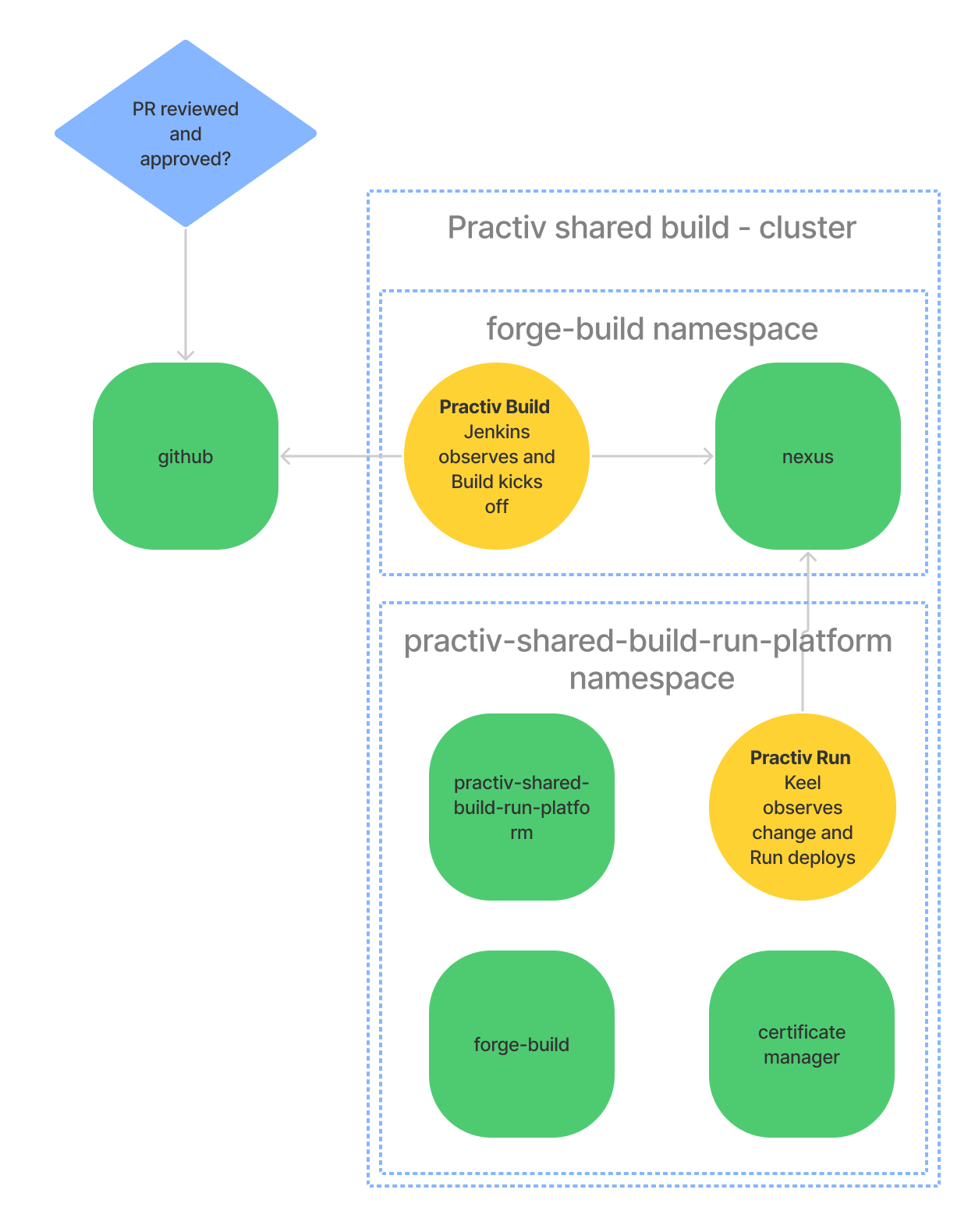Creating a Run Platform
A run platform is a special environment that deploys the definitions of environments, its a Maven project that produces a Docker image from a set of templates.
The result of creating a RUN Platform is a docker image with everything you need to seed a cluster and start deploying environments.
The RUN platform in pictures
This document describes how to create the image for the inner practiv-shared-build-run-platform box in the diagram, which is a more detailed view of what happens after a PR is approved and merged.

In this diagram practiv-shared-build-run-platform and forge-build are represented both as Namespaces and the containers that were used to build them.
These are the files you need
These are the files you need for a run platform environment
pom.xml
Jenkinsfile
src
└── main
└── kubernetes
└── forge-build
└── canary.yaml
environment.properties
Declare the project
pom.xml
<?xml version="1.0" encoding="UTF-8"?>
<project xsi:schemaLocation="http://maven.apache.org/POM/4.0.0 http://maven.apache.org/maven-v4_0_0.xsd"
xmlns="http://maven.apache.org/POM/4.0.0" xmlns:xsi="http://www.w3.org/2001/XMLSchema-instance">
<modelVersion>4.0.0</modelVersion>
<parent>
<groupId>io.practiv.stable.anvil</groupId>
<artifactId>anvil-parent</artifactId>
<version>#{anvil-parent.version}</version>
</parent>
<groupId>io.practiv.stable.practiv-shared-build</groupId>
<artifactId>practiv-shared-build-run-platform</artifactId>
<version>1.999-SNAPSHOT</version>
<packaging>jar</packaging>
<name>${project.artifactId}</name>
<description>Run Platform meta environment for Practiv</description>
<properties>
<properties>
<environmentDomain>practiv-shared-build.forge.practiv.io</environmentDomain>
<environmentColour>${tile-colour.gke}</environmentColour>
<clusterName>practiv-shared-build</clusterName>
</properties>
<build>
<plugins>
<plugin>
<groupId>io.repaint.maven</groupId>
<artifactId>tiles-maven-plugin</artifactId>
<version>2.34</version>
<configuration>
<tiles>
<tile>io.practiv.stable.anvil:anvil-tile-build:[1,2)</tile>
<tile>io.practiv.stable.anvil:anvil-tile-run:[1,2)</tile>
<tile>io.practiv.stable.chalk:chalk-run-platform-gke:[18,19)</tile>
</tiles>
</configuration>
</plugin>
<plugin>
<groupId>net.stickycode.plugins</groupId>
<artifactId>shifty-maven-plugin</artifactId>
<version>1.18</version>
<executions>
<execution>
<id>fetch-applications</id>
<phase>generate-resources</phase>
<goals>
<goal>fetch</goal>
</goals>
<configuration>
<outputDirectory>${project.build.directory}/resources/kubernetes</outputDirectory>
<unpack>true</unpack>
<artifacts>
<artifact>io.practiv.stable.forge:forge-build:[1,2]:run-platform:zip</artifact>
</artifacts>
</configuration>
</execution>
</executions>
</plugin>
</plugins>
</build>
</project>
Jenkinsfile
mavenBuild()
Set up the environment properties
The environment properties has the placeholders for all the the Kubernetes templates, the simplest way to find what’s missing is to run the build and let it fail
branchout-maven cv
snippet branchout-maven cv
UNRESOLVED CONFIGURATION FOUND in /charts/rocket-build/practiv-run-oauth-proxy/config.yaml
28- ".build.acme.practiv.io"
29- ]
30-
31- http_address = "0.0.0.0:4180"
32-
33: github_org="${githubOauthOrganisation}"
Then put the values in the environment properties file
environment.properties
githubOauthOrganisation=Practiv
githubOauthTeams=development,operators
githubUrl=https://git.practiv.io
Build it
Building the project will prompt for the missing Secrets and Configurations
mvn -f pom.xml -s /home/malt/branchout/acme/maven/settings.xml --no-transfer-progress clean verifyy
[INFO] Scanning for projects...
[INFO] --- tiles-maven-plugin: Injecting 14 tiles as intermediary parent artifacts for io.practiv.acme.stable.rocket:rocket-build...
...